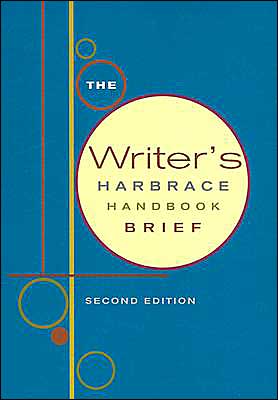Writer's Harbrace Handbook, Brief
The only brief handbook grounded in the rhetorical situation, THE WRITER'S HARBRACE HANDBOOK, BRIEF 2/E now features more coverage of visual rhetoric in a compact, spiral-bound and tabbed format.
Search in google:
The only brief handbook grounded in the rhetorical situation, THE WRITER'S HARBRACE HANDBOOK, BRIEF 2/E now features more coverage of visual rhetoric in a compact, spiral-bound and tabbed format.
W. THE WRITING PROCESS. 1. Reading and Writing Critically. Reading and writing as processes. Reviewing a text. Distinguishing content from personal response. The rhetorical situation. Engaging all elements of the rhetorical situation. 2. Planning and Drafting Essays. Finding appropriate subjects and focusing them. Stating a thesis clearly. Arranging ideas. Drafting with well-developed paragraphs. Experimenting with different strategies for development. Writing a first draft. 3. Revising and Editing Essays. Revision as a process. Introductions and conclusions. Unified and coherent paragraphs. Peer-reviewed draft. Editing. Proofreading. The final draft. 4. E-writing. Composing for the Web. Electronic mail (email). 5. E-designing. Visual elements of a Web site. Graphics (tables, charts, diagrams). Format and the rhetorical purpose. Format and readability. 6. Writing Arguments. Determining an argument's purpose. Establishing an arguable statement. Distinguishing between fact and opinion. Establishing a position or claim. Developing an effective argument. Using rhetorical appeals. Arranging an effective argument. Understanding logic. Recognizing rhetorical fallacies. Sample argument essay. R. RESEARCHING AND WRITING IN THE DISCIPLINES. 7. Finding Sources Online, in Print, and in the Field. Understanding research needs and methods. Choosing a topic and framing a research question. Navigating the Web. Using library resources. Conducting field research. 8. Evaluating Sources Online and in Print. Determining credibility of authors. Determining credibility of publishers. Evaluating Web sites and other online sources. Distinguishing bias from commitment. Recognizing relevant sources. 9. UsingSources Responsibly. Understanding a research paper's purpose. Taking notes. Creating a working bibliography. Integrating sources. Avoiding plagiarism. 10. Citing Sources and Submitting Final Papers. MLA-style documentation. MLA student paper. APA-style documentation. APA student paper. CMS documentation. 11. Writing Academic Discourse. How disciplines define evidence. How disciplines use evidence. Differences in language and style among disciplines. Discipline-specific formats and documents. 12. Writing to Interpret Literature. Recognizing literary genres. Using specialized vocabulary. Critical approaches to literature. Following special conventions. Sample literature essay. G. GRAMMAR. 13. Sentence Essentials. Subjects and predicates. Verbs. Subjects and complements. Basic sentence patterns. 14. Phrases and Clauses in Sentences. Phrases. Clauses. Sentence forms. 15. Sentence Fragments. Revising phrases punctuated as sentences. Revising clauses punctuated as sentences. Using fragments intentionally. 16. Comma Splices and Fused Sentences. Recognizing comma splices and fused sentences. Revising comma splices and fused sentences. Revising with transitional words and phrases. Dividing quotations. 17. Modifiers. Adjectives. Adverbs. Degrees of comparison. Nouns or word groups as modifiers. Correct placement of modifiers. Awkward or ambiguous modifiers. The double negative. 18. Pronouns. Kinds of pronouns. Subjective, objective, and possessive cases. Clause as determiner of pronoun case. Pronoun-antecedent agreement. Pronoun references. 19. Verbs. Verb forms. Verb tenses. Voice. Mood. Subject-verb agreement. S. EFFECTIVE SENTENCES. 20. Sentence Unity. Relating ideas clearly. Choosing and arranging details. Avoiding mixed metaphors and mixed constructions. Making subject and predicate relate logically. Adding necessary articles, conjunctions, and prepositions. Including all necessary verbs and auxiliaries. Making complete comparisons. Completing intensifiers. 21. Subordination and Coordination. Subordinating to combine short sentences. Subordinating and coordinating to relate clauses. Avoiding faulty or excessive subordination. 22. Parallelism. Balancing similar grammatical elements. Clarifying meaning within a sentence. Linking two or more sentences. Using correlative conjunctions. Emphasizing key ideas. 23. Emphasis. Placing words at the beginning or end of a sentence. Using periodic sentences. Arranging ideas from least to most important. Using active, forceful verbs. Repeating important words. Inverting word order. Varying sentence lengths. 24. Variety. Revising short, choppy sentences. Revising monotonous sentence openings. Varying the structure of compound sentences. Separating subjects and verbs. Using questions, commands, and exclamations. D. DICTION. 25. Good Usage. Usage and the rhetorical situation. Writing in a clear, straightforward style. Appropriate word choice. Inclusive (nonprejudiced) language. Benefits of dictionaries. Using a thesaurus. 26. Exactness. Choosing accurate words. Using fresh expressions. Understanding idioms. Using first and second person effectively. Providing clear definitions. 27. Making every word count. Eliminating needless words. Avoiding unnecessary repetition. Using pronouns and elliptical constructions. P. PUNCTUATION. 28. The Comma. Before coordinating conjunctions linking independent clauses. After introductory words, phrases, or clauses. Separating parallel elements. With nonessential (nonrestrictive) elements. With parenthetical elements. For ease in reading. Unnecessary or misplaced commas. 29. The Semicolon. Connecting independent clauses without a coordinating conjunction. Separating elements that contain commas. Misuse with unequal grammatical elements. 30. The Apostrophe. Indicating ownership and other relationships. Marking omissions of letters or numbers. Forming certain plurals. 31. Quotation Marks. With direct quotations, including dialogue. With titles of short works. For tone or emphasis of specific words. With other punctuation marks. 32. The Period and Other Punctuation Marks. The period. The question mark. The exclamation point. The colon. The dash. Parentheses. Square brackets. Ellipsis points. The slash. M. MECHANICS. 33. Spelling, the Spell Checker, and Hyphenation. Using a spell checker. Spelling and pronunciation. Spelling words that sound alike. Prefixes and suffixes. Confusion of ei and ie. Hyphenation. 34. Capitals. For proper names, their abbreviations, and acronyms. For titles that precede people's names. For the first, last, and all major words in titles. For the first word of sentences and directly quoted speech. Unnecessary capitals. 35. Italics. For titles of separate works. For foreign words. For names of legal cases. For names of specific ships, submarines, aircraft, spacecraft, and satellites. For words, letters, or figures referred to as such. For emphasis. 36. Abbreviations, Acronyms, and Numbers. Abbreviations before or after proper names. Abbreviations in addresses. Abbreviations in citations of research sources. Abbreviations as substitutes for certain words. Acronyms. Spelling out numbers. Special usage of numbers. Glossary of Usage. Glossary of Terms. Credits. English as a World Language Index. Index.








